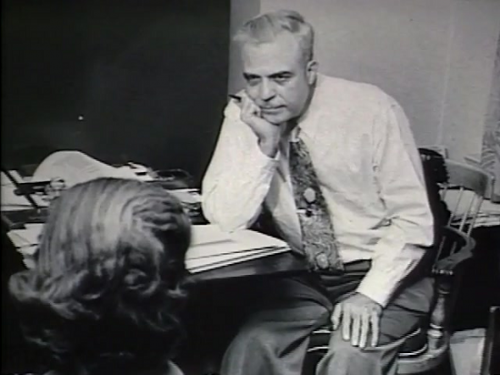Milton Erickson and Hypnosis

Milton Erickson is considered the father of modern hypnosis, now called hypnotherapy. This American doctor and psychologist was the pioneer of many hypnotherapy techniques. In addition, he was also an excellent family therapist.
Milton Erickson was born in Phoenix, Arizona in 1901. During that time, people still considered hypnosis an esoteric technique or circus. However, he made an effort to turn it into a valid therapeutic tool.
Several psychology schools of thought (especially behaviorism) influenced his work. He was the first president of the American Society of Clinical Hypnosis, which made him famous.
Milton Erickson’s origins
Milton Erickson didn’t have an easy life. His parents were low-class farmers and he suffered from several health problems. He only started to speak at the age of 4. At that age, he was diagnosed with dyslexia. He was also color blind and suffered from tone deafness.
When he was 17, he contracted poliomyelitis, which paralyzed him completely. He could only move his eyes. Although his doctors believed he wouldn’t improve, Erickson firmly believed that he’d recover. Thus, he became very attentive to his bodily sensations.

It’s safe to say that his condition forced him to become an excellent observer. Although he was sick, he tried to be aware of everything that was happening around him. This allowed him to detect and understand many aspec0ts of non-verbal language. By carefully observing his younger sister (who was taking her first steps), he learned to walk again.
Milton Erickson’s education
Despite his great limitations, Milton Erickson studied to become a doctor and psychologist. During this period, he analyzed Clark L. Hull’s theories of suggestibility. Said theories fascinated him so much that he began to thoroughly research hypnosis and everything related to it.
Over time, Milton Erickson started criticizing Hull’s practices. He also studied Sigmund Freud’s work but didn’t agree with his basic approaches. He believed hypnosis was a therapeutic tool. However, he thought that the patient should play a more active role.
“Our client’s problem is that they have lost rapport with their unconscious mind. Our job is to help restore that relationship.”
-Milton Erickson-

Milton Erickson and modern hypnosis
For Milton Erickson, therapeutic intervention wasn’t universal. He didn’t believe in applying it the same way with every patient. On the contrary, he stressed the importance of uniqueness and particularity. This explains why he believed that every process was different and, therefore, should be dealt with in a specific way. In other words, he used different techniques with each patient.
“There are no two people alike. No two people who understand the same sentence the same way. So, in dealing with people, you try not to fit them to your concept of what they should be.”
-Milton Erickson-
Milton Erickson’s main goal was to help his patients deal with the symptoms that afflicted them. To accomplish this, he even used unorthodox methods. That’s the reason why many considered him a “guru” or even a “magician”.
Unlike Freud, Milton Erickson didn’t really care about the patient’s past. He thought that it was more important to concentrate on the now, especially on solving current problems. He developed approaches that are still used today, such as neuro-linguistic programming and solution-focused brief therapy.
Other contributions
Even though Milton Erickson used hypnosis as his main therapeutic tool, he gradually started to use language as an instrument of transformation.
Milton Erickson was primarily a clinical psychologist. Developing new theories didn’t interest him that much. Instead, he focused on developing highly-effective practices that could help people.
At age 50, he suffered a new polio attack and took advantage of it to analyze the sensations and come up with pain management methods. In fact, he expressed this whole process in one of his books. He passed away at the age of 78.
Milton Erickson is considered the father of modern hypnosis, now called hypnotherapy. This American doctor and psychologist was the pioneer of many hypnotherapy techniques. In addition, he was also an excellent family therapist.
Milton Erickson was born in Phoenix, Arizona in 1901. During that time, people still considered hypnosis an esoteric technique or circus. However, he made an effort to turn it into a valid therapeutic tool.
Several psychology schools of thought (especially behaviorism) influenced his work. He was the first president of the American Society of Clinical Hypnosis, which made him famous.
Milton Erickson’s origins
Milton Erickson didn’t have an easy life. His parents were low-class farmers and he suffered from several health problems. He only started to speak at the age of 4. At that age, he was diagnosed with dyslexia. He was also color blind and suffered from tone deafness.
When he was 17, he contracted poliomyelitis, which paralyzed him completely. He could only move his eyes. Although his doctors believed he wouldn’t improve, Erickson firmly believed that he’d recover. Thus, he became very attentive to his bodily sensations.

It’s safe to say that his condition forced him to become an excellent observer. Although he was sick, he tried to be aware of everything that was happening around him. This allowed him to detect and understand many aspec0ts of non-verbal language. By carefully observing his younger sister (who was taking her first steps), he learned to walk again.
Milton Erickson’s education
Despite his great limitations, Milton Erickson studied to become a doctor and psychologist. During this period, he analyzed Clark L. Hull’s theories of suggestibility. Said theories fascinated him so much that he began to thoroughly research hypnosis and everything related to it.
Over time, Milton Erickson started criticizing Hull’s practices. He also studied Sigmund Freud’s work but didn’t agree with his basic approaches. He believed hypnosis was a therapeutic tool. However, he thought that the patient should play a more active role.
“Our client’s problem is that they have lost rapport with their unconscious mind. Our job is to help restore that relationship.”
-Milton Erickson-

Milton Erickson and modern hypnosis
For Milton Erickson, therapeutic intervention wasn’t universal. He didn’t believe in applying it the same way with every patient. On the contrary, he stressed the importance of uniqueness and particularity. This explains why he believed that every process was different and, therefore, should be dealt with in a specific way. In other words, he used different techniques with each patient.
“There are no two people alike. No two people who understand the same sentence the same way. So, in dealing with people, you try not to fit them to your concept of what they should be.”
-Milton Erickson-
Milton Erickson’s main goal was to help his patients deal with the symptoms that afflicted them. To accomplish this, he even used unorthodox methods. That’s the reason why many considered him a “guru” or even a “magician”.
Unlike Freud, Milton Erickson didn’t really care about the patient’s past. He thought that it was more important to concentrate on the now, especially on solving current problems. He developed approaches that are still used today, such as neuro-linguistic programming and solution-focused brief therapy.
Other contributions
Even though Milton Erickson used hypnosis as his main therapeutic tool, he gradually started to use language as an instrument of transformation.
Milton Erickson was primarily a clinical psychologist. Developing new theories didn’t interest him that much. Instead, he focused on developing highly-effective practices that could help people.
At age 50, he suffered a new polio attack and took advantage of it to analyze the sensations and come up with pain management methods. In fact, he expressed this whole process in one of his books. He passed away at the age of 78.
All cited sources were thoroughly reviewed by our team to ensure their quality, reliability, currency, and validity. The bibliography of this article was considered reliable and of academic or scientific accuracy.
- Erickson, M. H. Rossi. EL (1977). Autohypnotic Experiences of Milton H. Erickson. The American Journal of Clinical Hpnosis, 20(1), 36-54.
- Haley, J. (1980). Terapia no convencional: las técnicas psiquiátricas de Milton H. Erickson. Amorrortu.
- O’Hanlon, William Hudson. Raíces profundas: principios básicos de la terapia y de la hipnosis de Milton Erickson. Vol. 25. Grupo Planeta (GBS), 1993.
- Rosen, S., Wolfson, L., & Eickson Milton, H. (1987). Mi voz irá contigo: los cuentos didácticos de Milton H. Erickson.
This text is provided for informational purposes only and does not replace consultation with a professional. If in doubt, consult your specialist.







